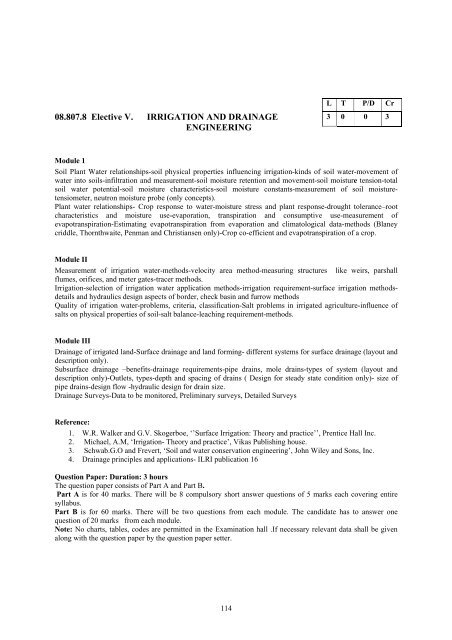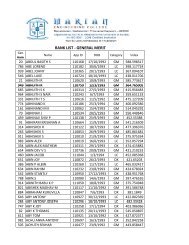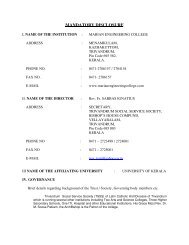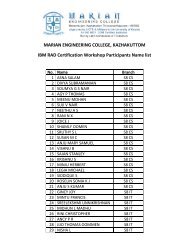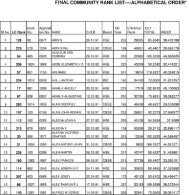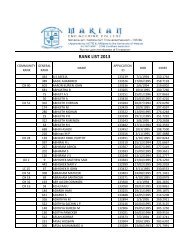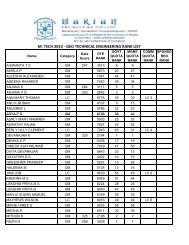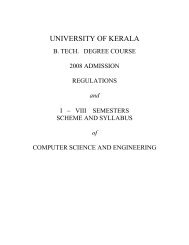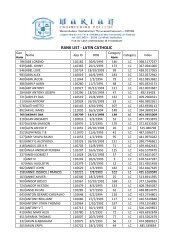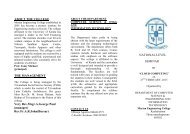UNIVERSITY OF KERALA - College of Engineering, Trivandrum
UNIVERSITY OF KERALA - College of Engineering, Trivandrum
UNIVERSITY OF KERALA - College of Engineering, Trivandrum
Create successful ePaper yourself
Turn your PDF publications into a flip-book with our unique Google optimized e-Paper software.
08.807.8 Elective V. IRRIGATION AND DRAINAGE<br />
ENGINEERING<br />
L T P/D Cr<br />
3 0 0 3<br />
Module 1<br />
Soil Plant Water relationships-soil physical properties influencing irrigation-kinds <strong>of</strong> soil water-movement <strong>of</strong><br />
water into soils-infiltration and measurement-soil moisture retention and movement-soil moisture tension-total<br />
soil water potential-soil moisture characteristics-soil moisture constants-measurement <strong>of</strong> soil moisturetensiometer,<br />
neutron moisture probe (only concepts).<br />
Plant water relationships- Crop response to water-moisture stress and plant response-drought tolerance–root<br />
characteristics and moisture use-evaporation, transpiration and consumptive use-measurement <strong>of</strong><br />
evapotranspiration-Estimating evapotranspiration from evaporation and climatological data-methods (Blaney<br />
criddle, Thornthwaite, Penman and Christiansen only)-Crop co-efficient and evapotranspiration <strong>of</strong> a crop.<br />
Module II<br />
Measurement <strong>of</strong> irrigation water-methods-velocity area method-measuring structures like weirs, parshall<br />
flumes, orifices, and meter gates-tracer methods.<br />
Irrigation-selection <strong>of</strong> irrigation water application methods-irrigation requirement-surface irrigation methodsdetails<br />
and hydraulics design aspects <strong>of</strong> border, check basin and furrow methods<br />
Quality <strong>of</strong> irrigation water-problems, criteria, classification-Salt problems in irrigated agriculture-influence <strong>of</strong><br />
salts on physical properties <strong>of</strong> soil-salt balance-leaching requirement-methods.<br />
Module III<br />
Drainage <strong>of</strong> irrigated land-Surface drainage and land forming- different systems for surface drainage (layout and<br />
description only).<br />
Subsurface drainage –benefits-drainage requirements-pipe drains, mole drains-types <strong>of</strong> system (layout and<br />
description only)-Outlets, types-depth and spacing <strong>of</strong> drains ( Design for steady state condition only)- size <strong>of</strong><br />
pipe drains-design flow -hydraulic design for drain size.<br />
Drainage Surveys-Data to be monitored, Preliminary surveys, Detailed Surveys<br />
Reference:<br />
1. W.R. Walker and G.V. Skogerboe, ‘’Surface Irrigation: Theory and practice’’, Prentice Hall Inc.<br />
2. Michael, A.M, ‘Irrigation- Theory and practice’, Vikas Publishing house.<br />
3. Schwab.G.O and Frevert, ‘Soil and water conservation engineering’, John Wiley and Sons, Inc.<br />
4. Drainage principles and applications- ILRI publication 16<br />
Question Paper: Duration: 3 hours<br />
The question paper consists <strong>of</strong> Part A and Part B.<br />
Part A is for 40 marks. There will be 8 compulsory short answer questions <strong>of</strong> 5 marks each covering entire<br />
syllabus.<br />
Part B is for 60 marks. There will be two questions from each module. The candidate has to answer one<br />
question <strong>of</strong> 20 marks from each module.<br />
Note: No charts, tables, codes are permitted in the Examination hall .If necessary relevant data shall be given<br />
along with the question paper by the question paper setter.<br />
114


